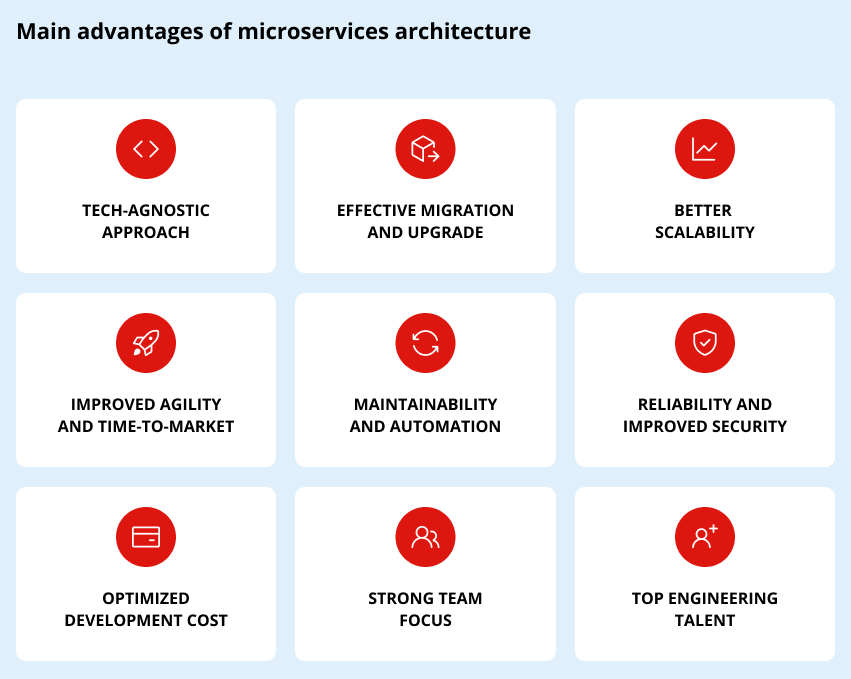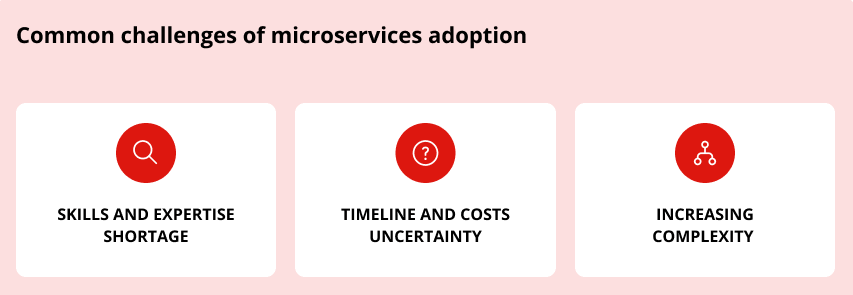10 Benefits of Microservices Architecture for Business
Microservices architecture is a proven approach to drive scalability, resilience, and agility to your business application.
According to the survey conducted by IBM Market Development & Insights to study the business advantages of microservices, 87% of IT executives and tech specialists believe that the efforts and cost of microservices adoption are worth it.
In this blog post, we talk about the key advantages of adopting microservices architecture and name a few baseline business cases for this approach. You will also learn about the challenges related to this model and the cons of microservices to think of before choosing this approach for your project.
Microservices architecture is a modern approach to building software applications out of a collection of individual modules (services). Each service is usually focused on performing a specific function (payment, shipping, etc.), has its own business logic, and can be developed with a custom set of technologies.
This provides agility both for the engineering teams and for the business itself. For instance, microservices-based applications are easier to scale. Individual services are often faster to develop and deploy compared to monolithic applications. And the list of microservices advantages only starts here.
In the next part, we drill into these and many other benefits of microservices. You’ll see how this approach helps companies build sustainable and high-performing applications, fast-track time to market, and effectively adapt to changes.
So what are the benefits of microservices architecture and how can they affect your business outcomes? Let’s find out!
Flexible approach to the choice of the tech stack
Each module in microservices works like a small application and thus can be built with a custom set of technologies, frameworks, and programming languages. This tech-agnostic approach allows business and engineering teams to select the tech stack that would work best for each component. As a result, they avoid unnecessary tradeoffs caused by the incompatibility of some technologies or ageing stack.
Effective migration and upgrade
The ability to quickly migrate to newer technologies is some of the important microservices benefits for fast-evolving applications. Companies can easier switch to the latest frameworks or tools when they deal with individual components. Instead of rewriting the entire code base for a large system, engineers develop and support smaller parts and can effectively upgrade on demand.
Needless to say, opting for microservices is a proven way to avoid technical debt and related expenses for large-scale modernization projects.

Better scalability
Undoubtedly, one of the strongest advantages of microservices architecture is unparalleled scalability and capacity to grow. Autonomous services can be scaled individually depending on the load and processing power requirements without affecting other services and inflating the cost of scalability.
It’s also easier and more cost-efficient to add new services and features to a modular system rather than to scale an entire monolith. Moreover, the risk of compromising system integrity is low since services are containerized, loosely coupled, and often have different logic.
Improved agility and time-to-market
On the other hand, services can be scaled unevenly. This helps companies better allocate time and resources and focus on developing the functionality that reflects current business goals and changing market needs. Eventually, this results in significant savings. Instead of investing in full-scale development of a large system, businesses can prioritize and keep a laser focus on critical modules and business functions.
High maintainability and automated deployment
The microservices ecosystem is easier to support and maintain thanks to the increased autonomy of different components. Every service can be updated frequently and deployed independently of other services. Modern DevOps tools and best practices of CI/CD for automated deployment allow to adjust this process to the changing needs of each team. This makes application development and deployment effective and error-free.
Reliability and reduced security risks
The structure of a modular system is reliable and stable because services are isolated. Should any error or security issue occur in one service, it won’t affect the performance of other components and therefore won’t cause a major problem for the system as a whole.
Along with other benefits of microservices architecture, this advantage makes microservices an obvious choice for modern business applications that have high security and operation requirements.
Optimized development time and cost
Despite significant costs associated with setting up an agile team and microservices infrastructure, this approach is widely recognized as a source of significant savings, especially in the long run. We have already mentioned several benefits that directly impact the bottom line – faster time to market, reduced costs for upgrading and scaling the system, etc.
Additionally, the flexible nature of microservices reflects on the team structure. It allows to leverage dedicated team model and build agile cross-functional teams – in-house and remote – responsible for specific modules or business functions. These teams can work in parallel thus boosting productivity and delivery speed.
Outsourcing opportunities
Companies that choose microservices can build flexible outsourcing strategies. They bring in resources faster to work on certain functional components or scale a part of an application. For instance, when a company wants to focus the effort of an in-house team on the core business functions and outsource less critical parts to vendors. This benefit, along with the next advantage of microservices architecture, transforms into real business value, especially in the long term.
Business agility and resilience
Microservices-based application is more resilient and adaptive to changes. And so is the business than runs it. This approach allows business to test assumptions and bring technologies for new business opportunities faster without significant investment or organizational changes.
Attractive for engineers
The last but not least point that supports microservices architecture advantages is high team satisfaction and a better chance to find top-tier engineers for app development. Generally, engineers are more likely to choose to work with a modern stack. Microservices is a modern approach that is associated with the latest engineering practices and developer tools. This alone is an important advantage for attracting strong specialists for the project.

This benefit is becoming increasingly relevant amid the growing shortage of tech specialists. Nowadays, this is one of the biggest issues that prevent companies from developing and scaling their systems as fast as they would want to.
Transition to microservices without risks
Plan, implement and scale your microservices while keeping focus on your key business goals
MICROSERVICES SERVICES
Just like with any other architectural approach, you should consider both pros and cons of microservices before opting for this strategy. Adoption of microservices, especially on projects that require large-scale re-architecture and migration from monolithic architecture, is often associated with certain challenges such as lack of in-house expertise, considerable upfront costs, and a range of uncertainties related to planning and data strategy.
Here are a few cons of microservices and common challenges that result from them.
Expertise shortage
Lack of relevant experience in the company can be a real challenge that may stall the project. Microservices development isn’t possible without relevant expertise in software architecture, infrastructure maintenance (DevOps automation, continuous integration and continuous delivery, etc.) and agile development. Many companies simply don’t have that at the start.

Hiring an experienced microservices development company is a viable strategy to solve this problem and kick off the project with a skilled cross-functional team from day one.
Need help with implementing microservices on your custom web portal development project? We have over a decade of experience designing, developing, and delivering reliable B2B and B2C portals for eCommerce, healthcare, education, etc. Contact our team to talk about your current business and technical needs.
Timeline and costs uncertainty
It can be problematic for a business to assess how to break down the system into modules, separate workflows, and work out an effective data strategy and security layers. There also may be uncertainties related to estimating the costs and timeline for migrating to microservices.

In-depth technology analysis is a proven way to cope with these uncertainties and develop the vision of the future microservices-based system as well as related documentation (technology stack, architectural diagram, specifications, etc.).
Increasing complexity
API-driven service oriented architecture has many structural parts. Therefore, it takes more resources to support the system and keep it running. It may also require a more complex testing strategy as services have little in common and require individual testing and debugging.
Monitoring and management
With great complexity comes great responsibility. As microservices infrastructure scales up and gets more heterogeneous, it requires monitoring and management practices and tools to ensure all services run and interoperate correctly. Otherwise, it may get out of hand.
Design challenges
One of the biggest challenges that companies confront when considering the pros and cons of microservices architecture is to decide which applications will benefit with transition to microservices and how to split services to bring real business value. It requires profound analysis and a good understanding of the company’s domain and business goals. To solve this challenge, architects combine the principles of domain driven design and microservices.

Despite these challenges, multiple advantages of microservices as well as real-world experience and proven bottom-line benefits encourage companies to shift towards microservices and further invest in this approach.
We have outlined microservices advantages and disadvantages and briefly mentioned the projects that thrive with this type of architecture. Next, we’ll talk about this in more detail and provide several examples of leveraging microservices on different projects.
So how do you know if microservices are a good fit for your project? Here are a few types of digital systems that benefit most from microservices architecture.
High-load web applications benefit from the scalability and resilience of modular architecture for web applications. These applications need to be able to seamlessly scale as the number of user requests grows. They need to withstand peak load without compromising performance and user experience. A global vendor portal is a good example of a feature-rich application that benefit from service oriented architecture.
Rapidly evolving solutions. Mature startups and rapidly evolving product companies that have already passed the MVP stage and work on market-ready systems choose microservices for agility, fast time-to-market, and the ability to quickly adjust to the changing technology landscape. Microservices give space to experiment with new functionality and technologies, quickly update applications and stay on top.
Success story. One of our clients, a Spain-based traveltech startup, leverages the benefits of microservices to develop and effectively scale a global platform for vacation rental management. Several autonomous teams work independently on different services in parallel thus keeping the fast pace of deliveries and continuously growing the system along with changing market needs.

Enterprise solutions. Large enterprise software typically consists of multiple applications, modules, and integrations with third-party or proprietary systems and works with multiple data sources. Modular architecture enables flexibility and reliability and ensures better data security which is critical for enterprise software. This approach works both for cloud-native and on-premises hosted solutions. It can also be adjusted to the unique requirements and infrastructure of the enterprise.
Multiple integrations. An API-driven application that integrates with multiple third-party services to expand its functionality is a natural fit for microservices adoption. Such applications usually have well-pronounced business functions which seamlessly transform into microservices. A good example is a large eCommerce portal that uses third-party services for inventory, order management, payment, shipping, loyalty, customer support modules.
Success story. A leading diagnostic data company in the UK set a goal to develop a network solution for precision medicine in record time. The company integrated over 50 proprietary and third-party services and leveraged microservices architecture benefits to build a large data-driven solution in less than a year. Since the first release in 2020, the system has received stellar market feedback and has been scaling in response to changing market needs.
Are you ready to start your microservices development project? Or perhaps you consider breaking down your existing system into microservices to improve scalability and boost performance?
During over 14 years in custom software development, we have been working with multiple microservices-based systems and right now help several clients migrate from monolith and leverage the advantages of modular architecture. Among such projects are SaaS and web applications for Printique (US), Diaceutics (UK), Origin Digital (IE), Lodgify (ES), and many others.
We can help you navigate through the advantages and disadvantages of microservices and develop a practical strategy for your migration or new project.
Our cross-functional dedicated teams cover every aspect of microservices software development including:
- Discovery, business analysis, scoping, and project planning
- System design and architecture
- UX/UI design and development
- Agile project management
- Software development (frontend, backend, full-stack)
- QA and test automation
- DevOps and infrastructure maintenance
- Data strategy, engineering, and management
We can take your large-scale project from zero or augment your agile team with senior tech specialists to help you reach your delivery goals faster.
Resilient application, resilient business
Tap into the benefits of using microservices architecture to become the most profitable and forward-looking business in your niche
HIRE MICROSERVICES EXPERTFinal thought
Microservices architecture certainly is a reliable and time-tested approach to building future-proof applications. As we went through the key microservices architecture pros and cons, we also showed that many concerns and challenges connected to this approach are manageable and solvable with the help of qualified tech teams and tech partnerships.
This post was originally published on April 14, 2022 and updated on February 21, 2023.
FAQ
- Increased agility and fast time to market
- Effective scalability and application update
- Optimized development costs
- High reliability, stability, and maintainability
- Flexibility in the choice of technologies
- Laser-focus on individual business functions
- Team autonomy
- Automated deployment and testing
- Better resource management
- Reduced/avoided technical debt







